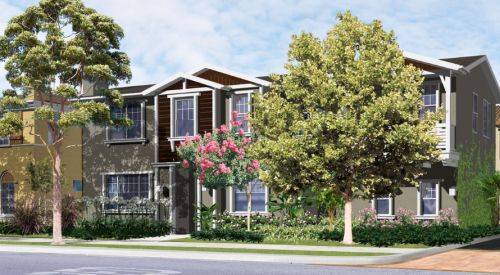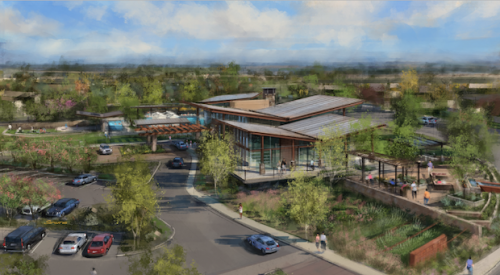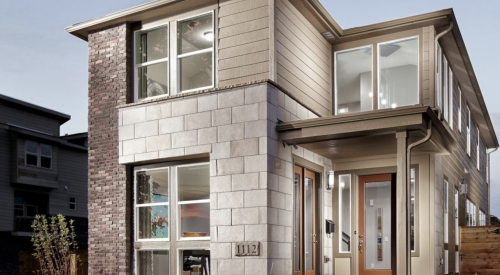
With almost three decades of experience in California real estate, Steve Cameron has seen his share of boom and bust markets and has navigated the Golden State’s entitlement gauntlet. Previously a senior executive at Fieldstone Communities, a private builder in Newport Beach, Calif., Cameron started his own land investment fi rm in 2007. Since then, Foremost Companies has owned or managed more than 12,000 single-family lots with a total retail value exceeding $1.4 billion. More than 6,000 lots have been sold to builders and investors, including parcels at Terramor, a master planned community near Corona, in Riverside County. The development is a venture with a Starwood Capital Group affiliate that will include neighborhoods for active adults as well as sections for all-age buyers.
Q: Baby Boomers are the largest buying group driving demand during the recovery, primarily for upscale homes. So why is the 55-plus population underserved in Riverside County?
A: If you’ve seen the work that John Burns and Chris Porter, of John Burns Real Estate Consulting, did in the book Big Shifts Ahead: Demographic Clarity for Businesses, they spend a lot of time talking about this. What’s amazing is that people 50 and over control more than 70 percent of the net worth, so it’s a great demographic to sell to because that’s where all the money is. When you look at Southern California, there have really been two opportunities for this demographic to buy in an age-qualified community. One would be on the coast, and the other is in Rancho Mission Viejo, a terrific project in Mission Viejo. But the issue there is that homes cost about $800,000 and up. The alternative is to go farther east to Beaumont, in the Inland Empire out in the desert, where homes are in the $400,000 price range and below. There’s really nothing between $400,000 and $800,000. That’s the segment of the market we’re going to target at Terramor. What’s nice about our location is that we’re right off Interstate 15. The state just wrapped up a $1.4 billion project that extended express tollways, so now drivers can go all the way from Orange County past Interstate 15 and be in an express toll lane driving 70 or 80 miles per hour the whole way instead of 10 to 20 miles per hour. So you can live at Terramor and be an hour’s drive from where most people probably are going to be moving from, which is LA County, Orange County, or somewhere else in the Inland Empire, and you’ll be at a price that’s not over $800,000 without having to go a lot farther east to get to a lower price.
Q: Terramor is set up so builders can sell to net worth rather than to net household income. What does that mean?
A: Remember what I said about this age demographic controlling 70 percent of the country’s net worth? Well, when you’re selling to Millennials, they haven’t had a lot of time in their lives to generate that net worth, so they have to qualify for a mortgage. When you’re selling to the 55-plus demographic, they have the net worth to buy outright, or these buyers may sell their older homes, ashing out the equity, and use that as either a down payment or for the outright purchase of the home at Terramor. One of the things we like about this is that we don’t think we’re going to be as sensitive to rising interest rates or changes in the mortgage market becausethe buyer we’re selling to isn’t going to be as dependent on mortgage debt for the acquisition of their home. We think a good number of residents will continue to work, but they don’t necessarily need income from their job to qualify them to purchase a home. They’ll be able to put down a down payment, if that’s what they want to do, or they will buy all-cash.
 Aerial view of Terramor. the 961-acre property will include 16 planned neighborhoods with features for 55-plus and all-age buyers.
Aerial view of Terramor. the 961-acre property will include 16 planned neighborhoods with features for 55-plus and all-age buyers.
Q: Why not target 55-plus for all of Terramor?
A: When we purchased Terramor in 2012 under an option contract, we weren’t thinking it would be an agequalified community. We were thinkingit would be a traditional market-rate community. But the more we studied the age-qualified market, the more we realized that it was a great opportunity to have at least a portion of Terramor be age-qualified. The reason we’re not making it all age qualified is two-fold. Some of the lots are probably too small to have an adequate size single-story home on them. They just lend themselves to a traditional two-story, market rate home. Secondly, one of the primarily reasons we are doing this is with 1,400 homes we want to make sure we can sell our land before the next market downturn. I don’t know when the next market downturn will be, but this plan allows us to have two different product types to sell to builders, so they are not competing with each other. We sold some land to KB Homes, so KB is going to build our market rate product. The square footages that KB will be building will overlap with Del Webb and Cal Atlantic who will be building the all age-qualified houses, but they really don’t compete with each other. They’re building two different product types, which allows us to accelerate our absorption.
Q: You saw the home building market about to take a dive in 2006 and founded Foremost to get in to the land acquisition business. Where do you think the home building industry is at in the current business cycle?
A: If you had told me when I started in this business ten years ago that in 2017 I would still be optimistic I would have told you in 2007 that you were crazy. But it’s really been an interesting housing recovery here in Southern California because so far the market has been driven by two buyer segments. It’s been driven by large Wall Street firms and other investors who have bought rental homes. They basically bought the distressed properties in the market. The other group has been international buyers. What you haven’t seen yet in Southern California is the traditional buyer who is buying because they got a job; they got a family; and they need a place to live. What we are seeing in 2017 is that buyer is coming back into the market, so I am optimistic that this cycle has got several more years to run. I don’t know if that is three, four, or five years, but I think there is more time.
The statistic that I really pay attention to is the employment-to-permit ratio, or the EP ratio. The rule of thumb when the ratio is 1 to 1.5 jobs being created for every permit being pulled, that traditionally is a really good market. The EP ratio in Southern California over the last couple of years has been 4 to 5. So a lot of jobs have been created, but the permits haven’t been pulled. The reason I think that the market is beginning to pick up now is I look at the EP ratio on a cumulative basis going back to 2006. I look at all the job losses that happened in the recession and run that through all the job gains we’ve had more recently and compare that to the permits that were pulled. If you run that now through the end of 2016, Southern California now, on a cumulative basis, is just about at 1.1 to 1.2 percent. So I think what happened is we have made up all the jobs that were lost relative to all the permits that were pulled, and we are now in a healthy EP ratio on a cumulative basis. I think that is why we’re seeing this pickup in the market right now. Clearly 2017 is starting out to be the best year we’ve had in Southern California for selling homes that we’ve had in a long time.
Q: Do you see anything regarding California’s land entitlement and permit procedures that provide any hope for that situation getting less lengthy?
A: The shortage of housing in California is a popular topic of conversation right now. Up in Sacramento (state capital) I read the other day that there are 130 bills pending or somewhere in the legislative process that would address housing. But at the end of the day it is a very difficult place to get land entitled through city councils and boards of supervisors. That is challenge number one. Then once you do get it approved, you got to survive the CEQA litigation (Editor’s Note: The California Environmental Quality Act requires a project that needs approval by a state or local agency have a report prepared and disclosed about all of that project’s environmental impacts) because most projects are going to have their CEQA litigated, so that’s tough.
Then I’ll tell you what the really hard part has become. Once you get through all that, you’re not done with all the challenges because then you have to get permits from a myriad of regulatory agencies whether it’s the flood control district, the regional water quality control board, the Army Corps of Engineers, the California Department of Fish and Wildlife, and if you are ever in a situation where you need to coordinate two or three of those agencies, it’s extremely challenging because they each have a different agenda. It’s a fine needle you’ve got to thread to get these agencies to agree because their agendas are all different. I’m not saying they’re wrong or right. I’m saying they just are what they are and that’s hard. So once you get through the entitlements and the SEQA, you’ve still got a ways to go.
That’s why most projects are behind schedule in Southern California because they haven’t anticipated the difficulty and the time to get the permits you need to get from the agencies. Many of the agencies, being government agencies, tend to be understaffed. Everyone is worried about deficits so that is the easiest place not to staff people. You’ve got great people there but they’ve have too much to do.
Q: Since housing is a top of mind issue, do you see any inkling that there is any push afoot making the entitlement and permitting process shorter?
A: I know Governor (Jerry) Brown tried to streamline CEQA last year. That was not well received. Every local agency said they want to retain control over their land use. Everyone wants a house built. They just don’t want it built near them. It’s really difficult. Whether you’re doing infill projects or greenfield projects there are issues regardless of what Sacramento would like to see or whatever all these 130 pending bills would like to have happen. It all comes down to local government and neighbors.













